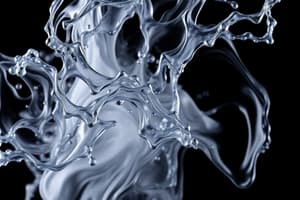Podcast
Questions and Answers
What characterizes an incompressible fluid?
What characterizes an incompressible fluid?
- Fluid is typically a gas
- Density varies significantly during flow
- Volume of fluid changes over time
- Density remains nearly constant throughout (correct)
Which flow classification depends on the mean velocity and the fluid's viscosity?
Which flow classification depends on the mean velocity and the fluid's viscosity?
- Compressible vs. Incompressible Flow
- Natural vs. Forced Flow
- Viscous vs. Inviscid Flow (correct)
- Steady vs. Unsteady Flow
Which type of flow is induced by external means, such as pumps or fans?
Which type of flow is induced by external means, such as pumps or fans?
- Laminar Flow
- Turbulent Flow
- Forced Flow (correct)
- Natural Flow
What differentiates turbulent flow from laminar flow?
What differentiates turbulent flow from laminar flow?
What aspect is critical for distinguishing between internal and external flow?
What aspect is critical for distinguishing between internal and external flow?
Which flow classification refers to the variation of fluid properties being consistent throughout its motion?
Which flow classification refers to the variation of fluid properties being consistent throughout its motion?
Which of the following is NOT a characteristic used to classify fluid flows?
Which of the following is NOT a characteristic used to classify fluid flows?
Which type of flow relies on natural phenomena like buoyancy?
Which type of flow relies on natural phenomena like buoyancy?
Flashcards are hidden until you start studying
Study Notes
Fluid Mechanics Overview
- Fluid mechanics studies fluids at rest (fluid statics) and in motion (fluid dynamics).
- Fluid behavior is vital in applications such as engineering, meteorology, and aerodynamics.
Characteristics of Fluids vs. Solids
- Fluids can flow and conform to the shape of their containers, unlike solids which maintain shape.
- No-slip condition describes the scenario where fluid in contact with a solid surface has zero velocity relative to that surface.
Classification of Fluid Flows
- Viscous vs. Inviscid Flow: Viscous flow includes the effects of viscosity, while inviscid flow neglects these effects.
- Internal vs. External Flow: Internal flow occurs in confined spaces (like pipes), whereas external flow is over surfaces (like air over an airplane).
- Compressible vs. Incompressible Flow: Compressible flow involves significant density changes (like gases), while incompressible flow assumes constant density (like most liquids).
Characteristics of Incompressible Flow
- Density remains nearly constant during flow, ensuring the volume of fluid does not change.
Types of Flow Based on Behavior
- Laminar Flow: Smooth and orderly, characterized by low Reynolds number (Re).
- Turbulent Flow: Chaotic and irregular, occurring with high Reynolds number; defined by eddies and swirls.
Additional Flow Classifications
- Natural Flow: Driven by natural forces (e.g., buoyancy effects), such as the rise of warm air.
- Forced Flow: Achieved by external means (e.g., pumps, fans) to drive fluid movement.
- Steady Flow: Fluid properties do not change with time at any point in the fluid.
- Unsteady Flow: Fluid properties vary with time at one or more points.
Uniform vs. Non-Uniform Flow
- Uniform Flow: Fluid velocity is consistent throughout a flow field.
- Non-Uniform Flow: Fluid velocity varies at different locations within the flow.
Dimensions and Measurement
- Quantitative description of fluids necessitates comparative standards for measurements. Both a number and a unit are needed for clarity and communication in scientific contexts.
Studying That Suits You
Use AI to generate personalized quizzes and flashcards to suit your learning preferences.




